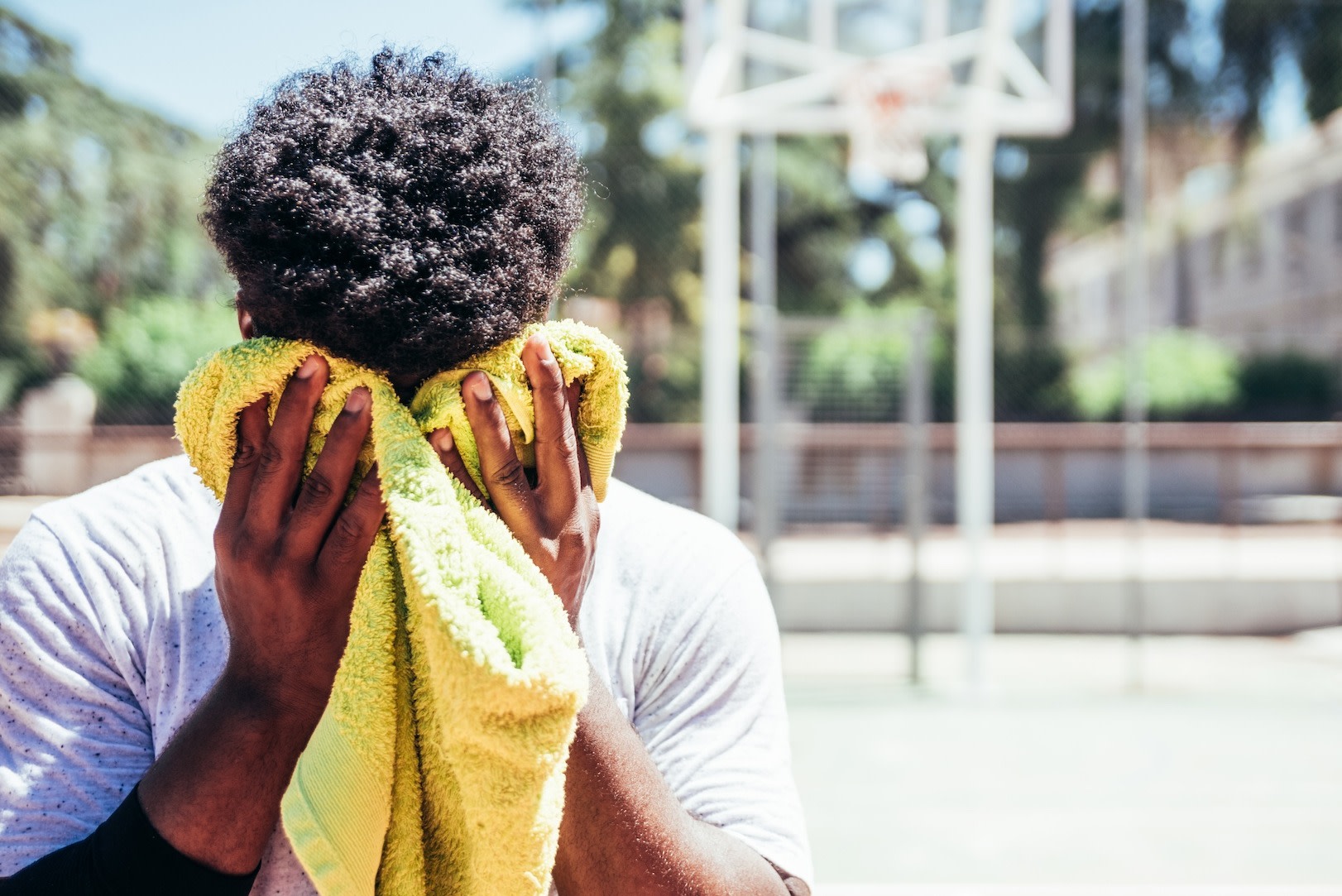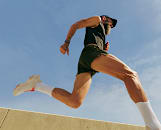
Cavan Images / Cavan via Getty Images
Is Your Workout Wreaking Havoc on Your Skin? Here’s How to Treat and Prevent Sweat Pimples
We asked dermatologists for their pro tips on warding off sweat pimples, no matter how intense your workout gets.
By Ayren Jackson-Cannady•
What Are Sweat Pimples?
What Causes Sweat Pimples?
How to Get Rid of Sweat Pimples
Can You Prevent Sweat Pimples?
The Takeaway
If you’ve revved up your workout routine and have noticed some unwelcome sweat pimples pop up on your face or body as a result, you’re not alone. By hitting the gym on the regular, your skin becomes susceptible to a barrage of sweat, oil, dirt, and bacteria—making the ideal breeding ground for breakouts.
Discover more ways to reach your goals with Peloton
Yet as frustrating as they are, sweat pimples aren’t cause for backing off your workouts. We spoke with dermatologists to learn more about the causes, treatments, and prevention strategies for all things sweat pimples. Here’s what you need to know.
What Are Sweat Pimples?
Sweat pimples—also known as sweat-induced acne, folliculitis, acne mechanica, or miliaria, depending on the cause of your breakout or the medical expert you’re talking to—are small, inflamed bumps that develop on the skin due to a combination of sweat, bacteria, dirt, and oil clogging pores. They typically manifest as red or white bumps and can appear on various parts of the body, including the face, chest, back, and buttocks, says Deanne Mraz, MD, a board-certified dermatologist and an assistant clinical professor of dermatology at Yale University of Medicine in New Haven, Connecticut.
“These breakouts often happen in areas where your body perspires during a workout or physical activity and typically appear in clusters or patches where there is friction from clothing on the body during a workout, such as a bra strap or headband,” Dr. Mraz notes. “This type of acne is technically triggered by moisture and friction.”
How Are Sweat Pimples Different from Acne and Heat Rash?
Sweat pimples, acne, and heat rash are like three peas in a pod. While sweat pimples share similarities with traditional acne, such as inflammation and clogged pores, they are distinct in their timing and triggers, says Christina Chung, MD, a board-certified dermatologist at Schweiger Dermatology Group in Philadelphia. Unlike acne, which can develop independently of physical activity, sweat pimples are directly linked to exercise-induced sweat and friction. And while acne may linger for days or weeks, sweat pimples often crop up shortly after exercise and may subside relatively quickly once skin is cleansed.
“Scientifically, acne affects the hair follicles and sweat pimples affect the sweat ducts, which are different skin structures,” Dr. Chung says. “You also do not see the blackheads or whiteheads traditionally associated with acne in sweat pimples, and cystic lesions generally do not occur.”
Similarly, heat rash (aka prickly heat) occurs when sweat becomes trapped in the skin’s sweat ducts, leading to redness and irritation. Sweat pimples, however, are characterized by the formation of inflamed bumps rather than a diffuse rash, Dr. Mraz says.
“[Like with sweat pimples,] heat rash also affects the outer layer of the skin,” Dr. Mraz says. “However, heat rash will typically be really itchy and appear in folds of the skin (behind the knees, underarms, and creases of the elbows) versus where the skin rubs against fabric.”
What Causes Sweat Pimples?
When you get sweaty during a workout, that sweat can mix with bacteria, dirt, and oil, which can clog pores and prompt a breakout. But excessive sweat alone isn’t solely responsible for sweat pimples; rather, says Dr. Mraz, it exacerbates the following underlying factors that contribute to acne formation:
Genetic predisposition: Your genes influence various biological pathways involved in skin health, which can make you more or less likely to experience acne from exercise.
Hormonal fluctuations: Fluctuations in estrogen and progesterone levels during puberty, menstruation, pregnancy, and menopause can lead to increased sebum production and changes in the skin’s microbiome, making it more susceptible to acne.
Staying in tight, non-breathable clothing: “If you sit around in your sweaty workout clothes all day, you’re providing the most ideal environment for the acne bacteria to thrive, and this will likely lead to skin irritation and breakouts,” Dr. Mraz says.
How to Get Rid of Sweat Pimples
Before you pull out your face wash and toner, it’s important to remember that treating sweat pimples on the body is similar (but not identical) to treating acne on the face.
Generally, dermatologists recommend gently cleansing your skin before and after workouts to remove makeup, sweat, oil, and bacteria. Using a mild, non-comedogenic cleanser can help unclog pores without stripping the skin of its natural oils. Just avoid over-washing or harsh scrubbing (as tempting as it is), as this can exacerbate inflammation and irritation.
Meanwhile, spot treatments containing ingredients like benzoyl peroxide or salicylic acid can target existing pimples and prevent new ones from forming, says Joshua Zeichner, MD, a board-certified dermatologist, associate professor of dermatology, and director of cosmetic and clinical research in dermatology at the Mount Sinai Hospital in New York City.
As far as moisturizers and other body care products are concerned, “be sure to stick to oil-free, non-comedogenic face and body care products,” Dr. Mraz recommends. Using topical treatments infused with skin-soothing ingredients like calamine and menthol is another treatment best practice, Dr. Chung says, in addition to wearing loose clothing and staying out of the heat.
Can You Prevent Sweat Pimples?
The good news: You can prevent sweat pimples. In fact, “the best way to treat sweat pimples is to prevent them from developing to begin with,” Dr. Zeichner says.
Preventing sweat pimples involves proactive skincare measures before, during, and after exercise. Here are a few pro tips to consider at each point of your exercise journey:
Before Exercise
Here are a few steps you can take to prepare your skin and minimize the risk of sweat pimple breakouts before your workout even begins:
Cleanse your skin: Use a gentle cleanser or wipe to remove makeup, dirt, oil, and bacteria before starting your workout. This helps prevent the accumulation of impurities that can clog pores during exercise.
Apply moisturizer: Use a lightweight, oil-free moisturizer to hydrate your skin without clogging pores. “You can also apply a barrier cream anywhere you know fabric friction causes you irritation; for example, a swipe of Aquaphor® on your bra strap line,” Dr. Mraz says.
Wear breathable clothing: Opt for activewear made with moisture-wicking fabrics to help keep skin dry and minimize friction. Looser, airier fits can help, too: “It might not be the fashion rage these days, but wearing more loose-fitting, breathable clothing during exercise is the best way to prevent sweat pimples,” Dr. Chung says.
During Exercise
To prevent sweat pimples during exercise, here are a few ways you can keep skin clean and minimize the buildup of sweat, oil, and bacteria:
Use oil-free sunscreen: If you’re exercising outdoors, apply oil-free sunscreen to protect your skin from UV damage. Choose a non-comedogenic formula that won’t clog pores or contribute to acne breakouts.
Use a clean towel: Carry a clean towel with you to blot away sweat during your workout, Dr. Mraz says. Avoid wiping or rubbing the towel vigorously, as this can irritate your skin and spread bacteria. Gently patting your skin helps absorb excess sweat without causing friction.
Avoid touching your face: Try not to touch your face during exercise to minimize the transfer of bacteria and oils from your hands to your face, which can exacerbate acne breakouts and increase the risk of developing sweat pimples.
Wipe off shared exercise equipment: At the gym using a communal mat or machine? Make sure to wipe it down before use to avoid contacting acne-provoking bacteria, advises the American Academy of Dermatology.
After Exercise
To prevent sweat pimples after exercise, it’s essential to cleanse your skin thoroughly to remove all the grime that may have accumulated during your workout. Here are some specific action items to consider:
Shower ASAP: Take a shower or rinse off immediately after exercising to remove sweat, dirt, and acne-causing bacteria from your skin, Dr. Mraz says. Use a gentle cleanser to thoroughly cleanse your face and body, paying special attention to areas prone to sweat pimples, such as your chest, back, and shoulders.
…Or at least use antimicrobial wipes: If showering immediately isn’t an option, Dr. Zeichner suggests using antimicrobial wipes to cleanse your skin and remove sweat and bacteria. Look for wipes specifically designed for post-workout use to help keep skin fresh and clean while on the go.
Change into clean clothes: Swap out your sweaty workout clothes for clean, dry threads as soon as possible to prevent bacterial buildup and friction on your skin. Avoid staying in damp clothing for an extended period, as this can contribute to the development of sweat pimples, Dr. Mraz says.
Apply acne treatment: If you’re prone to sweat pimples, consider applying an acne treatment containing ingredients like salicylic acid or benzoyl peroxide after showering, Dr. Chung suggests. These ingredients help to unclog pores, reduce inflammation, and prevent breakouts.
The Takeaway
For many exercisers, sweat pimples aren’t unusual. Understanding their causes and implementing effective treatment and prevention strategies can help maintain clear, healthy skin. By adopting gentle cleansing habits, wearing appropriate workout attire, and incorporating skincare products tailored to your skin type, you can minimize the impact of sweat pimples and enjoy the benefits of an active lifestyle without compromising your skin health.

Peloton App
Access thousands of classes with no equipment needed.
This content is for informational and educational purposes only and does not constitute individualized advice. It is not intended to replace professional medical evaluation, diagnosis, or treatment. Seek the advice of your physician for questions you may have regarding your health or a medical condition. If you are having a medical emergency, call your physician or 911 immediately.
This content is for informational and educational purposes only and does not constitute individualized advice. It is not intended to replace professional medical evaluation, diagnosis, or treatment. Seek the advice of your physician for questions you may have regarding your health or a medical condition. If you are having a medical emergency, call your physician or 911 immediately.
Get our latest health stories straight to your inbox
Enter your email to get articles, expert-backed tips, and updates from Peloton sent to your inbox.
By providing your email address, you agree to receive marketing communications from Peloton.
For more about how we use your information, see our Privacy Policy.







